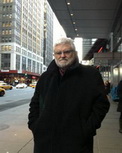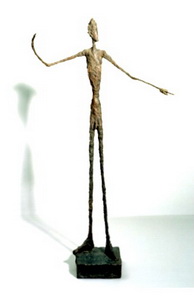 Chris
McDonnell, UK
Chris
McDonnell, UK
chris@mcdonnell83.freeserve.co.uk
Previous articles by Chris Comments
welcome here
May
31, 2017
Signs
of the Times?

A
highly-acclaimed Exhibition of the work of Alberto Giacometti opened
recently at Tate Modern on the South Bank in
London
. Giacometti, a Swiss, born in 1901 became one of the
outstanding European artists of the 20th Century. His later
sculpture, the slender drawn-out images of the human form, instantly
recognisable as his signature work.
In
so many ways they reflect the
Europe
of his time, the anguish brought about by fascist
regimes, the full impact of which only slowly became apparent with the end
of the War in 45. It was in the 40s that these stick-like figures emerged,
gaunt and shadowy, threatening shapes of a starved humanity. They showed
the consequences of total war when unbridled savagery was visited upon
nations. The hopeless expressiveness of humanity reduced in its very
physicality to a shadow of its former self is almost too much to bear.
His
artistic expression, reflected the times he lived through, the sights he
saw and the stories he heard.
We
all face similar consequences of being born when we were and living now in
the resultant history of our time. One thing I always remember from a
post-War
London
childhood was a greyness, a drabness that was later to
be replaced by the colour and energy of the 60s.
It is no small wonder that the Church of
our time has in a similar way been influenced and change by the milieu of
these years. That very word, milieu, came into common currency after the
publication of Teilhard de Chardin’s book, Le
Milieu Divin. It attempts to define our physical and spiritual
experience in the Universe and to bring us into the presence of the Cosmic
Christ. First written in the mid-20s, its publication was banned by Church
authorities, it was too radical, questioned too much and offered concepts
and understandings that were hard to acknowledge. It was to remain
unpublished till the year after his death, on Easter Sunday 1956.
Even when its title is offered in English it is partly translated
to ‘The Divine Milieu’. The French word ‘milieu’
is of course much older but it has become accepted within our English
culture without translation.
We
are what we are, alive in the society of the 21st Century,
shaped and influenced by the tumultuous times we have experienced. Dylan
might have sung of “Times they are a changin’ ” but for some
that change has not been accepted as a reality, they still live in a
shadow of earlier years, where so much was in contrast and direct
contradiction to our time now. Their refusal to face reality threatens all
of us.
There
is certainly a greater global awareness, the slowly emerging realisation
that human life on earth is actually transforming our planetary home to
the detriment of life. It is quite amazing that the
US
, under its new President, is considering withdrawal
from
Paris
agreement on climate change.
It
is hard letting go when the comfort blanket of childhood is no longer
appropriate, when facts cannot be ignored, however unfortunate the
consequences of acceptance.
This
is where Francis has taken us with his constant call to love, for the
essence of our love with God comes before everything, the moral code and
prescriptive actions can only succeed if the platform of love is secure.
The emphasis on Commandments, the do’s
and don’t’s, cannot precede love.
In
the early months of life, a baby relates to its parents through the love
it experiences, the touch, the cuddle and gentleness of bath time and the
comfort and nourishment of milk at its mother’s breast. Only later,
after the mutual bonding has taken place, can rules begin to be formed and
patterns of behaviour understood. I have yet to find a six month old baby
respond to the verbal instruction not to soil a nappy. In fact, that
reminds me of the definition of a baby – ‘irresponsible at one end
and irrepressible at the other’.
The
words of Jesus remind us of this prior need, that we should ‘love one
another as I have loved you’.
Giacometti’s
tall, thin elongations of the human form constantly point to the fragility
of our lives and the need for the nourishment of love.
Having
spent many years admiring his work through books and images, I am
determined to find a way of experiencing the visual reality of a man whose
genius is reflected in the acclaim he receives. One of his figures was on
display in the dockside Liverpool Tate when I visited with school
children. We sat on the floor together in silence. No words were needed.
The London Tate exhibition closes in early September. Get along if you
can.
END
----------------------
 Chris
McDonnell, UK
Chris
McDonnell, UK Chris
McDonnell, UK
Chris
McDonnell, UK